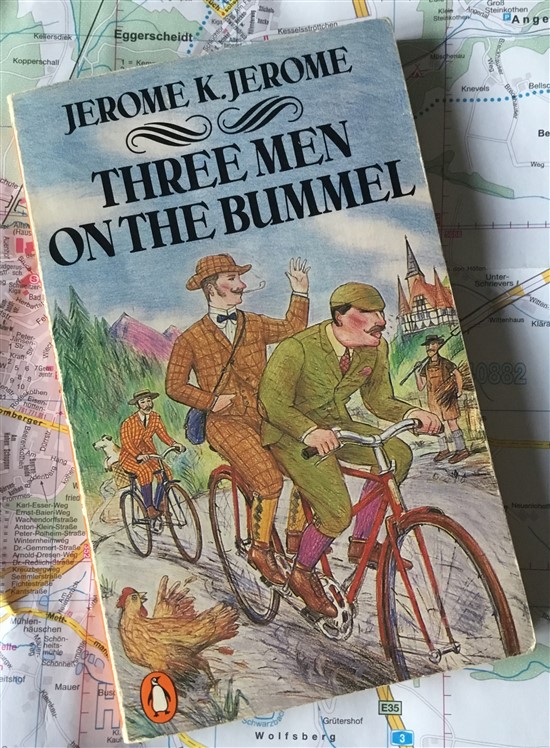On a walk through Ewelme last weekend I passed the grave of Jerome K Jerome. Jerome is best known for Three men in a boat which has never been out of print since publication in 1889. He also wrote Three men on the bummel, which follows the same three characters from the boat book as they embark on a cycling holiday in Germany. Published in 1900, Three men on the bummel, hasn’t achieved the lasting success of Three men in a boat. But as far as I’m concerned it’s the better read. It has two things the earlier book doesn’t: a long-distance cycle tour, and European travel.

Jerome K Jermoe knows a thing or two about what can go right – and wrong – on a bicycle tour. He also knows that the cycling world is divided into those who like to fiddle endlessly with their bikes, ‘overhaulers’ as he calls them, and those who believe that if something is working, it is best left alone. He definitely falls into the latter camp. And, after a few early mishaps at the roadside with tiny screws and nuts, I am now firmly in that camp too.
Some of characters from my novel Peloton of Two are overhaulers. Nick Farne definitely is. In fact, when we first encounter him in chapter 2 of the book, he’s wearing a head-torch and making tiny adjustments to the wheels of his newly built tandem. He could have been celebrating a perfect first day of cycling at a nearby country pub. But that’s not who he is:
A few minutes later they passed through a kissing gate and found themselves in a gloomily lit camping area. Just inside its fence line were three ancient caravans, deserted and in disrepair, their shells daubed with streaks of lurid green mould. Beyond them the path wound past a stone-walled toilet block. As she rounded the corner of this Catherine saw two lights at the far end of the field. The first was set low to the ground. Its diffuse glow told her that this was their new gas micro-lantern. The other, an intense, narrow-focused blue-white beam, jigged and bobbed in the air like a drunken, high-voltage glow-worm.
From the shape of the light-cone she knew this was Nick, wearing a head-torch exactly like the one he had given her at Base Camp. He turned as she approached and blinded her with a blast of high-intensity light. When her eyes had recovered she saw that he had picked up the gas lantern and was holding it in front of the tandem.
‘Well,’ he said, grinning ferociously, ‘what do you think?’
The tandem’s lustrous yellow frame glowed in the gas light, inviting her to reach out and run a finger along its enamelled steel top tube. It was cold from the night air and damp with condensation but this only added to its sense of strength. The frame rested on a pair of gleaming alloy wheels, each with a plate-sized disc brake set into the hub. The front handlebars, those ahead of Nick’s seat, were traditional touring drops, curling like ram’s horns above the front wheel.
Catherine Pringle on the other hand would always fall into the leave things alone if they’re working camp. She wouldn’t dream of maintaining her bicycle unless she absolutely has to. Partly this is because she is a late-comer to cycling. But it’s also not in her nature. This difference in them eventually comes to a head when she realises that she’s enjoying summer in France just a little too much. On Bastille Day, Catherine writes this in her blog:
In 18 cycling days since we rolled off the ferry at Roscoff we’ve covered only 960 kilometres. Almost, but not quite, a quarter of the target distance. But there’s still a long way to go, another 3,000 kilometres, and a rapidly shrinking number of days still available.
The cause? Too much of the good life: good food, good wine and good company. It’s beginning to take its toll. And, I have to confess, it’s almost entirely my fault. It’s summer, we’re in France, and I’ve been insisting we enjoy ourselves just a little too much.
At a crisis meeting in Bergerac today we agreed that things will have to change. It was lunchtime by the way, and yes, we were eating from a fixed menu at a restaurant of my choosing. There was a small quantity of wine too, white wine, which I’m pretty sure doesn’t count when it’s consumed at lunchtime. Does it?
I know what you’re thinking – this all sounds very Marie Antoinette. Which is exactly how the discussion began to make me feel.
Between the entrée and the main course, Nick unrolled his precious schedule, a document he treats with a religious reverence. It tells us where we should be and what we should be doing on every day of the remaining two months.
He showed me where we should be by now. And it really wasn’t good news. The schedule had us more than 500 kilometres to the south-west. Almost enough to put me off my main course.
Until then, I was a non-believer. I didn’t want to be on a tour that needed plans to keep it on track. But I can see now how wrong I was. On a long-distance journey, one with limited time, there’s nothing more necessary than a plan. And, like any recent convert, there’s a pretty good chance that I’m going to be fundamentalist about it from now on.
Catherine is beginning to change. But will her new-found passion for cycling turning her into one of Jerome K Jerome’s ‘overhaulers’? Only time will tell.
Jerome K Jerome is just one of many writers who developed a passion for cycling. Charlotte Jones in the Guardian has a fascinating article on this. The article has some great photos of Hardy, Conan Doyle and even Tolstoy with their bicycles. I just love the one of Tolstoy.
